大学英美文学讲义
- 格式:doc
- 大小:594.00 KB
- 文档页数:34
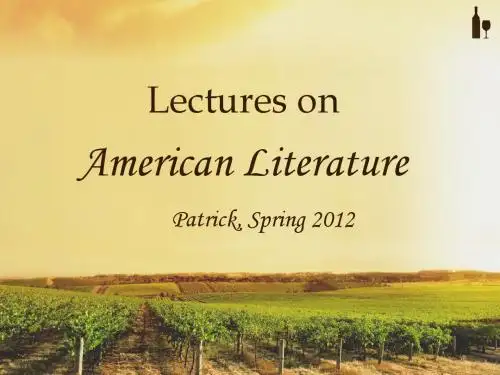
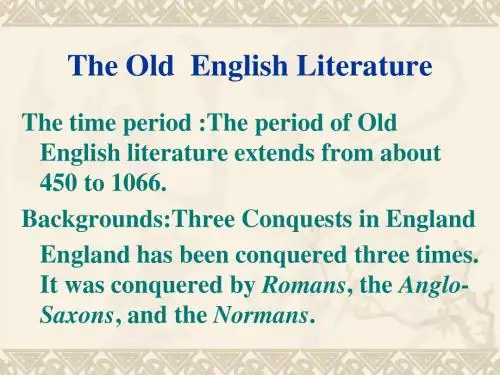
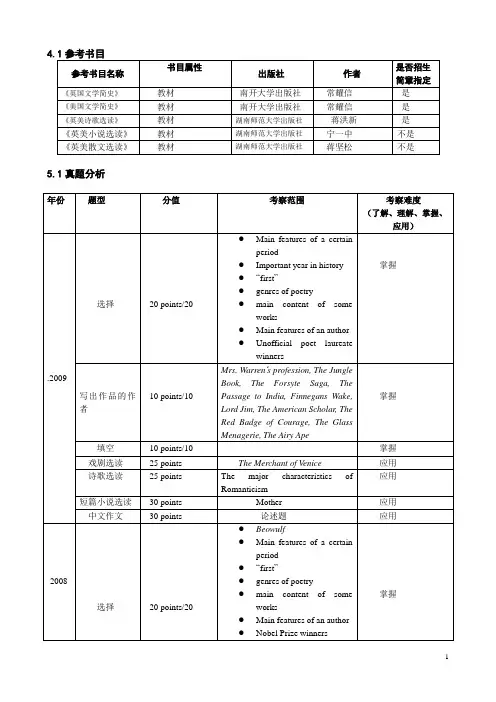
5.1真题分析2、第2本书《美国文学简史》:5.3重点知识点汇总分析(大纲)第七部分大学英语语言文学专业英美文学与中文作文基础知识点框架梳理及基础阶段,复习时间是从5月份至9月份或10月份,这一阶段需要大家认真看完《英国文学史》与《美国文学史》,理清文学史的线索,例如文学史的大致分期,每一阶段的大致时间,社会背景,思想背景及每一阶段的代表人物及其代表作。
文学史这两本书每本至少看两遍。
文学史的复习方法主要以熟悉知识点为主,脑海中线索清晰,重点部分最好能在理解的基础上识记。
文学史的复习时应注意归纳总结出一下内容:●英美文学史的大致分期(整合标题)、每一时期大致的时代背景及思想特征.●记住每一时期最重要的作家及作品,知道文学的基本常识,例如文学术语。
●主要作品的故事情节,主要人物,人物形象,主题思想,作品评价。
A Survey of English History ChangYaoxinA Glossary of Literary Terms:For the convenience of discussion, historians divide the continuity of English literature into segments of time which are called “p eriods”. The e xact numbers, dates and names of these periods vary, but the list below conforms on each period, in chronological order.450-1066 Old English (or Anglo-Saxon)Period Chapter11066-1500 Middle English Period Chapter1、2文学成就不是很高。
文学形式:骑士浪漫传奇;抒情歌谣;神秘剧、传奇剧及道德剧骑士浪漫传奇:《亚瑟王和他的圆桌骑士》、《高文爵士和绿衣骑士》、《查理大帝的传奇》、《亚历山大的传奇》等抒情歌谣:短诗,大多数比较悲哀、凄凉,例如英国的Robin Hood神秘剧:取材于《圣经》中的旧约全书,上帝耶和华传奇剧:《新约》,基督1500-1660 The Renaissance(or Early Modern) Chapter3-4思想、文化、文学运动,最初出现在意大利,然后遍及其他国家。
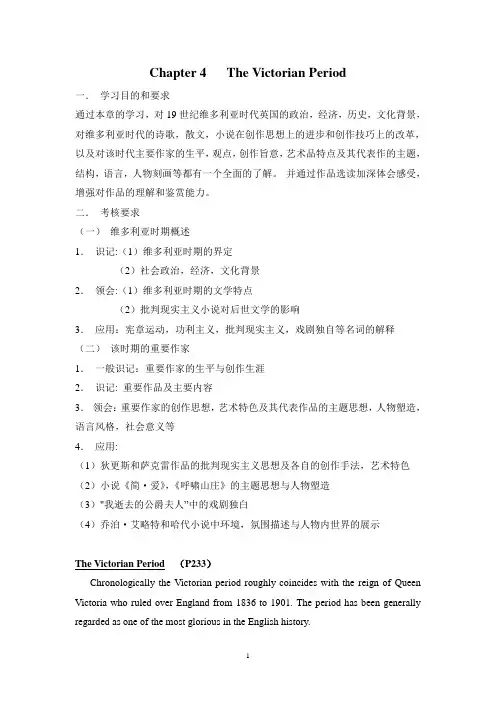
Chapter 4 The Victorian Period一.学习目的和要求通过本章的学习,对19世纪维多利亚时代英国的政治,经济,历史,文化背景,对维多利亚时代的诗歌,散文,小说在创作思想上的进步和创作技巧上的改革,以及对该时代主要作家的生平,观点,创作旨意,艺术品特点及其代表作的主题,结构,语言,人物刻画等都有一个全面的了解。
并通过作品选读加深体会感受,增强对作品的理解和鉴赏能力。
二.考核要求(一)维多利亚时期概述1.识记:(1)维多利亚时期的界定(2)社会政治,经济,文化背景2.领会:(1)维多利亚时期的文学特点(2)批判现实主义小说对后世文学的影响3.应用:宪章运动,功利主义,批判现实主义,戏剧独自等名词的解释(二)该时期的重要作家1.一般识记:重要作家的生平与创作生涯2.识记: 重要作品及主要内容3.领会:重要作家的创作思想,艺术特色及其代表作品的主题思想,人物塑造,语言风格,社会意义等4.应用:(1)狄更斯和萨克雷作品的批判现实主义思想及各自的创作手法,艺术特色(2)小说《简·爱》,《呼啸山庄》的主题思想与人物塑造(3)"我逝去的公爵夫人”中的戏剧独白(4)乔泊·艾略特和哈代小说中环境,氛围描述与人物内世界的展示The Victorian Period (P233)Chronologically the Victorian period roughly coincides with the reign of Queen Victoria who ruled over England from 1836 to 1901. The period has been generally regarded as one of the most glorious in the English history.Its Political, Economical & Cultural Background(P233)The early years of the Victorian England was a time of rapid economic development as well as serious social problems. After the Reform Bill of 1832 passed the political power from the decaying aristocrats into the hands of the middle-class industrial capitalists, the Industrial Revolution soon geared up. Towards the mid-century, England had reached its highest point of development as a world power. And yet beneath the great prosperity & richness, there existed widespread poverty & wretchedness among the working class. The worsening living & working conditions, the mass unemployment & the new Poor Law of 1834 with its workhouse system finally gave rise to the Chartist Movement宪章运动(1836-1848).During the next twenty years, England settled down to a time of prosperity & relative stability. The middle-class life of the time was characterized by prosperity, respectability & material progress.But the last three decades of the century witnessed the decline of the British Empire & the decay of the Victorian values.Ideologically, the Victorians experienced fundamental changes. The rapid development of science & technology, new inventions & discoveries in geology, astronomy, biology & anthropology drastically shook people's religious convictions. Darwin's The Origin of Species《物种起源》(1859) & The Descent of Man《人类的起源》(1871) shook the theoretical basis of the traditional faith. On the other hand, Utilitarianism功利主义was widely accepted & practiced. Almost everything was put to the test by the criterion of utility, that is, the extent to which it could promote the material happiness. (P235)Features of the Victorian LiteratureVictorian literature, as a product of its age, naturally took on its quality of magnitude & diversity. It was many-sided & complex, & reflected both romantically & realistically the great changes that were going on in people's life & thought. Greatwriters & great works abounded. (P235)Features of Victorian novels(P236)In this period, the novel became the most widely read & the most vital & challenging expression of progressive thought. While sticking to the principle of faithful representation of the 18th-century realist novel, novelists in this period carried their duty forward to the criticism of the society & the defense of the mass. Although writing from different points of view & with different techniques, they shared one thing in common, that is, they were all concerned about the fate of the common people. They were angry at the inhuman social institutions, the decaying social morality as represented by the money-worship & Utilitarianism & the widespread misery, poverty & injustice. Their truthful depiction of people's life & bitter & strong criticism of the society had done much in awakening the public consciousness to the social problems & in the actual improvement of the society.(P236)Victorian literature, in general, truthfully represents the reality & spirit of the age. The high-spirited vitality, the down-to-earth earnestness, the good-natured humor & unbounded imagination are all unprecedented. In almost every genre it paved the way for the coming century, where its spirits, values & experiments are to witness their bumper harvest. (P237)名词解释(Definitions of several terms)The Chartist Movement (1836-1848) (P233)The English workers got themselves organized in big cities & brought forth the People's charter, in which they demanded basic rights & better living & working conditions. They, for three times, made appeals to the government, with hundreds of thousands of people's signatures. The movement swept over most of the cities in the country. Although the movement declined to an end in 1848, it did bring some improvement to the welfare of the working class. This was the first mass movement of the English working class & the early sign of the awakening of the poor, oppress-ed people.Utilitarianism (P235)Almost everything was put to the test by the criterion of utility, that is, the extent to which it could promote the material happiness. This theory held a special appeal to the middle-class industrialists, whose greed drove them to exploiting workers to the utmost & brought greater suffering & poverty to the working mass.Critical RealismThe Victorian Age is an age of realism rather than of romanticism-a realism which strives to tell the whole truth showing moral & physical diseases as they are. To be true to life becomes the first requirement for literary writing. As the mirror of truth, literature has come very close to daily life, reflecting its practical problems & interests & is used as a powerful instrument of human progress.Dramatic MonologueBy dramatic monologue, it is meant that a poet chooses a dramatic moment or a crisis, in which his characters are made to talk about their lives, & about their minds & hearts. In “listening” to those one-sided talks, readers can form their own opinions & judgments about the speaker's personality & about what has really happened. Robert Browning brought this poetic form to its maturity & perfection & his "My Last Duchess"《我的已故公爵夫人》is one of the best-known dramatic monologues.Victorian WritersI. Charles Dickens (P238)His Life & Literary CareerCharles Dickens (1812-1870) was born at Portsmouth. His father, a poor clerk in the Navy Pay office, was put into the Marsalsea Prison for debt when young Charles was only 12 years old. The son had to give up schooling to work in an underground cellar at a blacking factory - a position he considered most humiliating. We find the bitter experiences of that suffering child reflected in many of Dickens's novels. In 1827, Charles entered a lawyer's office, & two years later he became a Parliamentaryreporter for newspapers.From 1833 Dickens began to write occasional sketches of London life, which were later collected & published under the title Sketches by Boz《博兹札记》(1836). Soon The Posthumous Papers of the Pickwick Club《匹克威克外传》(1836-1837) appeared in monthly installments. And since then, his life became one of endless hard work. In his later years, he gave himself to public readings of his works, which brought plaudits & comfort but also exhausted him. In 1870, this man of great heart & vitality died of overwork, leaving his last novel unfinished. (P238)His Major WorksUpon his death, Dickens left to the world a rich legacy of 15 novels & a number of short stories. They offer a most complete & realistic picture of English society of his age & remain the highest achievement in the 19th-century English novel. In nearly all his novels, behind the gloomy pictures of oppression & poverty, behind the loud humor & buffoonery, is his gentleness, his genial mirth, his simple faith in mankind.The following is a list of his novels & other collections in three periods:(1) Period of youthful optimistSketches by Boz (1836); The Posthumous Papers of the Pickwick Club (1836-1837); Oliver Twist《雾都孤儿》(1837-1838); Nicholas Nickleby《尼古拉斯·尼克贝》(1838-1839); The Old Curiosity Shop《老古玩店》(1840-1841); 《巴纳比·拉奇》Barnaby Rudge(1841)(2) Period of excitement & irritationAmerican Note s《美国札记》(1842); Martin Chuzzlewit《马丁·翟述伟》(1843-1845); A Christmas Carol《圣诞颂歌》(1843); Dombey & Son《董贝父子》(1846-1848); David Copperfield《大卫·科波菲尔》(1849-1850)(3) Period of steadily intensifying pessimismBleak House《荒凉山庄》(1852-1853); Hard Times《艰难时世》(1854); Little Dorrit 《小杜丽》(1855-1857); A Tale of Two Cities《双城记》(1859); Great Expectations 《远大前程》(1860-1861); Our Mutual Friend《我们共同的朋友》(1864-1865); EdwinDrood《艾德温·德鲁德之谜》(unfinished)(1870)Distinct Features of His Novels(1) Character Sketches & ExaggerationIn his novels are found about 19 hundred figures, some of whom are really such " typical characters under typical circumstances," that they become proverbial or representative of a whole group of similar persons.As a master of characterization, Dickens was skillful in drawing vivid caricatural sketches by exaggerating some peculiarities, & in giving them exactly the actions & words that fit them: that is, right words & right actions for the right person.(2) Broad Humor & Penetrating SatireDickens is well known as a humorist as well as a satirist. He sometimes employs humor to enliven a scene or lighten a character by making it (him or her) eccentric, whimsical, or laughable. Sometimes he uses satire to ridicule human follies or vices, with the purpose of laughing them out of existence or bring about reform.(3) Complicated & Fascinating PlotDickens seems to love complicated novel constructions with minor plots beside the major one, or two parallel major plots within one novel. He is also skillful at creating suspense & mystery to make the story fascinating.(4) The Power of ExposureAs the greatest representative of English critical realism, Dickens made his novel the instrument of morality & justice. Each of his novels reveals a specific social problem.His Literary Creation & Literary AchievementsCharles Dickens is one of the greatest critical realistic writers of the Victorian Age. It is his serious intention to expose & criticize in his works all the poverty, injustice, hypocrisy & corruptness he saw all around him. In his works, Dickens sets a full map & a large-scale criticism of the 19th-century England, particularly London. A combination of optimism about people & realism about society is obvious in these works. His representative works in the early period include Oliver Twist,DavidCopperfield & so on. (P239)His later works show a highly conscious modern artist. The settings are more complicated; the stories are better structured. Most novels of this period present a sharper criticism of social evils & morals of the Victorian England, for example, Bleak House, Hard Times, Great Expectations & so on. The early optimism could no more be found.Charles Dickens is a master story-teller. His language could, in a way, be compared with Shakespeare's. His humor & wit seem inexhaustible. Character-portrayal is the most outstanding feature of his works. His characterizations of child (Oliver Twist, etc.), some grotesque people (Fagin, etc.) & some comical people (Mr. Micawber, etc.) are superb. Dickens also employs exaggeration in his works. Dickens's works are also characterized by a mixture of humor & pathos. (P241)Selected ReadingAn Excerpt from Chapter III of Oliver Twist(P238)The novel is famous for its vivid descriptions of the workhouse & life of the underworld in the 19th-century London. The author's intimate knowledge of people of the lowest order & of the city itself apparently comes from his journalistic years. Here the novel also presents Oliver Twist as Dickens's first child hero & Fagin the first grotesque figure. (P243)This section, Chapter III of the novel, is a detailed account of how he is punished for that " impious & profane offence of asking for more" & how he is to be sold. At three pound ten, to Mr. Gamfield, the notorious chimneysweeper. Though we can afford a smile now & then, we feel more the pitiable state of the orphan boy & the cruelty & hypocrisy of the workhouse board.It was the best of times, it was the worst of times, it was the age of wisdom, it was the age of foolishness, it was the epoch of belief, it was the epoch of incredulity, it was the season of Light, it was the season of Darkness, it was the spring of hope, itwas the winter of despair, we had everything before us, we had nothing before us, we were all going direct to Heaven, we were all going direct the other way.A Tale of Two Cities这是最好的时代,也是最坏的时代;这是智慧的年代,也是愚蠢的年代;这是信仰的时期,也是怀疑的时期;这是光明的季节,也是黑暗的季节;这是希望的春天,也是失望的冬天;大伙儿面前应有尽有,大伙儿面前一无所有;大伙儿正在直登天堂;大伙儿正在直落地狱。

4*4’英国2218’B1分)C2A1分)2>1—2分)3>2—3分)4>1—2分)5>3—4分)1>时间+来源(0.5分—1分)3>2—3分)4> 1分)5>0.5—1分)6>0.5—1分)3>1—2分)4>2—3分)5>1—2分)6>0.5—1分)介绍论述题中关于作1>0.5—1分)2>1—2分)1>0.5—1分)2>1—2分)literary trend1798-1832Lyrical Ballads in 1798Walter Scott's death in 1832.is a literary trend.It prevailed in(place)during the period of xxxx-xxxx,beginning with xxxx in (time),ending with in(time).was greatly influenced by the.Generally speaking, the expressed the ideology and sentiment of those classes......The great writers in this period are............时期th to mid-17th )时期 1.<<>>2.3.1.2. 1.2.3.pun 3.英国文学 1.2.3.1.英国小说之父the father of English Novels2.讽刺satire1.2.3. 1.2.details细腻英国文学Period Period1836-1901 1.2.3.T ·S4.1.2.critical realist 3.4.3.4.5. 1.2.1.2.1.2.3.4.5.6.现实Period 美国文学1.2.3.4.5.老人与海6.现代Period1.2.3.4.浪漫Period1.Old English Literature-(450——1066封建建立)a. Religious-——b. Secular--heroic age---<Beowulf>盎格鲁撒克逊人的史诗---a protector of people, fight against the nature.————•••例题例题【正确答案:B】Background:a by a①The of&②The new in&the&本质与主张③The in&to get rid of to new ideas that the the&to the of the early from theEngland①---②都铎)Traits of humanistic poetry: dramatistsWriters:1.早期---andPetrarchan)2.中期the Ageblank verse)3.后期抽象founder of modern science)Life381542I.5 history plays and 4 comedies. (apprenticeship 学徒时期)•5•III>;and.•4部.•,II. 5 history plays ,6 comedies and 2 tragedies (style became highly individualized)•5II>,I,II,V>•6()••to•and•and loyal•其他•II. 5 history plays ,6 comedies and 2 tragedies (style became highly individualized) 2III. The Third stage---peak of his creation, included his greatest tragedies and his so-called dark comedies: ---Greatest four tragedies:<Hamlet><King Lear><Othello><Macbeth>III. The Third stage---peak of his creation, included his greatest tragedies and his so-called dark comedies:---Theme: The impossibility of certainty; the complexity of action;the mystery of death;the nation as a diseased body.blood-and-thunderand butIV. Principal Romantic tragicomedies: <The Tempest>①.②forth byto the one he人物塑造独白情节结构语言风格Paradise Lost<Lycidas挽歌<Areopagitica><Paradise LostThe is the“Fall of Man”.流放<Paradise Regained诱惑<Samson Agonistes>①②③④⑤例题例题【正确答案:B】background:Time:Background:Traits:Thoughts:节俭迷信EnlightmentLiterature ideas:教导.<A Modest ProposalLiterature ideas:Schools of literature:Daniel Defoe, Samuel Richardson, Henry Fielding, Laurence Sterne, Tobias George Smollett, and Oliver Goldsmith.2.Gothic novels ⋯⋯⋯Schools of literature:Daniel DefoeThe True born Englishman wonThe Review<Robinson Crusoe>②③坚韧④the lower-class people.选读<Robinson Crusoe> Theme:①②③创作风格:①②③方言。
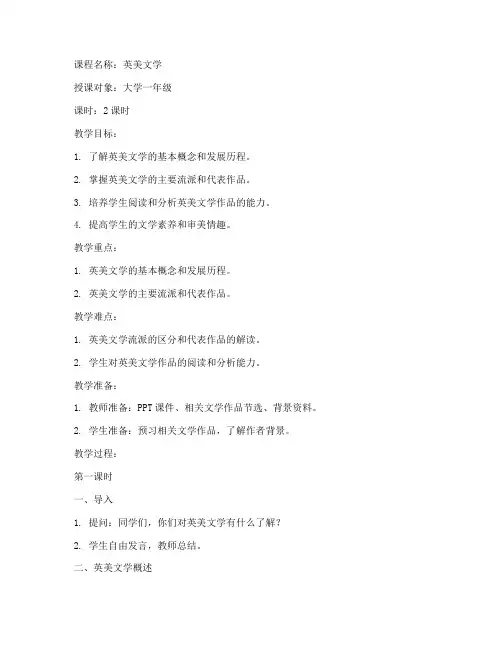
课程名称:英美文学授课对象:大学一年级课时:2课时教学目标:1. 了解英美文学的基本概念和发展历程。
2. 掌握英美文学的主要流派和代表作品。
3. 培养学生阅读和分析英美文学作品的能力。
4. 提高学生的文学素养和审美情趣。
教学重点:1. 英美文学的基本概念和发展历程。
2. 英美文学的主要流派和代表作品。
教学难点:1. 英美文学流派的区分和代表作品的解读。
2. 学生对英美文学作品的阅读和分析能力。
教学准备:1. 教师准备:PPT课件、相关文学作品节选、背景资料。
2. 学生准备:预习相关文学作品,了解作者背景。
教学过程:第一课时一、导入1. 提问:同学们,你们对英美文学有什么了解?2. 学生自由发言,教师总结。
二、英美文学概述1. 介绍英美文学的基本概念和发展历程。
- 英美文学是指英语文学,包括英国文学和美国文学。
- 英国文学历史悠久,从古英语文学到现代文学,经历了多个发展阶段。
- 美国文学在19世纪末开始崛起,逐渐形成独特的文学风格。
2. 讲解英美文学的主要流派:- 古典主义:强调理性、秩序和道德规范。
- 浪漫主义:强调感情、个性和自然。
- 现实主义:关注社会现实,揭示社会矛盾。
- 现代主义:追求形式创新,打破传统文学规范。
三、代表作品介绍1. 英国文学代表作品:- 《哈姆雷特》:莎士比亚的代表作,探讨生死、命运和人性。
- 《傲慢与偏见》:简·奥斯汀的经典小说,揭示英国乡村社会的婚姻观念。
2. 美国文学代表作品:- 《了不起的盖茨比》:弗朗西斯·斯科特·基·菲茨杰拉德的长篇小说,反映美国梦的破灭。
- 《老人与海》:欧内斯特·海明威的短篇小说,展现人类与自然的斗争。
四、课堂小结1. 总结本节课所学内容。
2. 强调英美文学的重要性。
第二课时一、复习导入1. 提问:上节课我们学习了哪些内容?2. 学生回顾,教师总结。
二、作品分析1. 学生分组,选择一本英美文学作品进行讨论和分析。
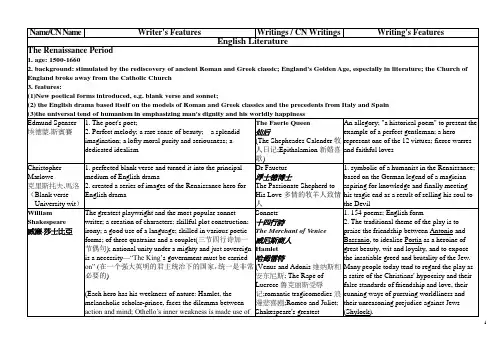
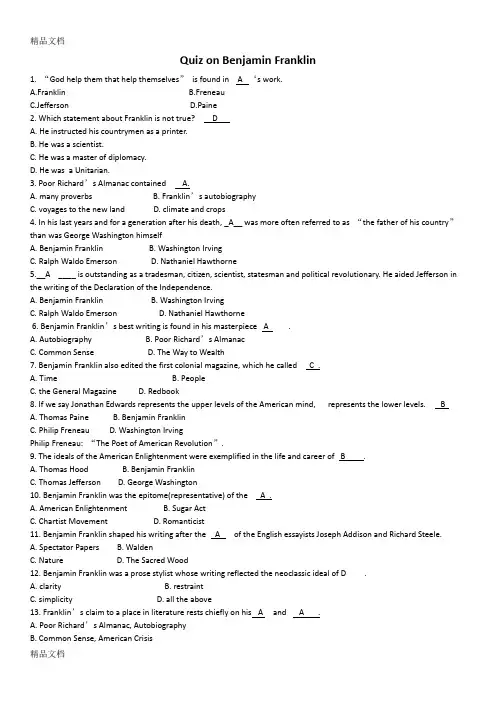
Quiz on Benjamin Franklin1. “God help them that help themselves”is found in A ‘s work.A.FranklinB.FreneauC.JeffersonD.Paine2. Which statement about Franklin is not true? DA. He instructed his countrymen as a printer.B. He was a scientist.C. He was a master of diplomacy.D. He was a Unitarian.3. Poor Richard’s Almanac contained A.A. many proverbsB. Franklin’s autobiographyC. voyages to the new landD. climate and crops4. In his last years and for a generation after his death, _A__ was more often referred to as “the father of his country”than was George Washington himselfA. Benjamin FranklinB. Washington IrvingC. Ralph Waldo EmersonD. Nathaniel Hawthorne5.__A ____ is outstanding as a tradesman, citizen, scientist, statesman and political revolutionary. He aided Jefferson in the writing of the Declaration of the Independence.A. Benjamin FranklinB. Washington IrvingC. Ralph Waldo EmersonD. Nathaniel Hawthorne6. Benjamin Franklin’s best writing is found in his masterpiece A .A. AutobiographyB. Poor Richard’s AlmanacC. Common SenseD. The Way to Wealth7. Benjamin Franklin also edited the first colonial magazine, which he called C .A. TimeB. PeopleC. the General MagazineD. Redbook8. If we say Jonathan Edwards represents the upper levels of the American mind, represents the lower levels. BA. Thomas PaineB. Benjamin FranklinC. Philip FreneauD. Washington IrvingPhilip Freneau: “The Poet of American Revolution”.9. The ideals of the American Enlightenment were exemplified in the life and career of B .A. Thomas HoodB. Benjamin FranklinC. Thomas JeffersonD. George Washington10. Benjamin Franklin was the epitome(representative) of the A .A. American EnlightenmentB. Sugar ActC. Chartist MovementD. Romanticist11. Benjamin Franklin shaped his writing after the A of the English essayists Joseph Addison and Richard Steele.A. Spectator PapersB. WaldenC. NatureD. The Sacred Wood12. Benjamin Franklin was a prose stylist whose writing reflected the neoclassic ideal of D .A. clarityB. restraintC. simplicityD. all the above13. Franklin’s claim to a place in literature rests chiefly on his A and A .A. Poor Richard’s Almanac, AutobiographyB. Common Sense, American CrisisC. The Wild Honeysuckle, The Indian Burying GroundD. Rights of Man, The Age of ReasonPhilip Freneau(1752-1832)美国殖民时期著名诗人,美国革命战争后期最杰出的作家。
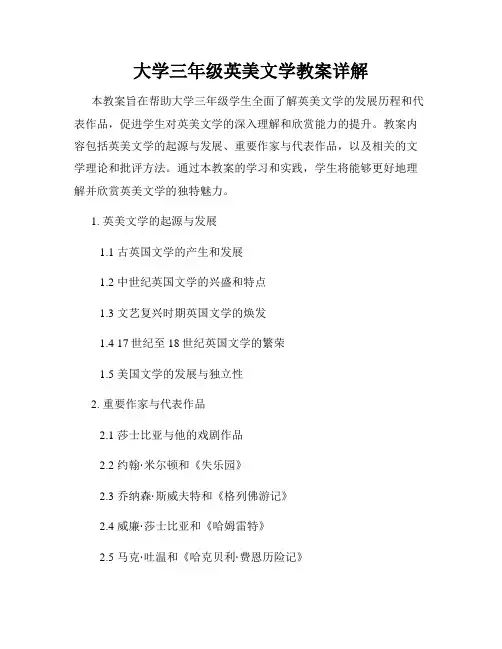
大学三年级英美文学教案详解本教案旨在帮助大学三年级学生全面了解英美文学的发展历程和代表作品,促进学生对英美文学的深入理解和欣赏能力的提升。
教案内容包括英美文学的起源与发展、重要作家与代表作品,以及相关的文学理论和批评方法。
通过本教案的学习和实践,学生将能够更好地理解并欣赏英美文学的独特魅力。
1. 英美文学的起源与发展1.1 古英国文学的产生和发展1.2 中世纪英国文学的兴盛和特点1.3 文艺复兴时期英国文学的焕发1.4 17世纪至18世纪英国文学的繁荣1.5 美国文学的发展与独立性2. 重要作家与代表作品2.1 莎士比亚与他的戏剧作品2.2 约翰·米尔顿和《失乐园》2.3 乔纳森·斯威夫特和《格列佛游记》2.4 威廉·莎士比亚和《哈姆雷特》2.5 马克·吐温和《哈克贝利·费恩历险记》3. 文学理论与批评方法3.1 结构主义与批评3.2 形式主义与批评3.3 传统批评与新批评3.4 后现代主义与批评4. 教学策略与方法4.1 融入多媒体教学手段,提升学生学习兴趣4.2 引导学生参与讨论和互动,培养批判性思维能力4.3 设计文学作品分析和鉴赏的小组活动4.4 提供阅读材料和作品欣赏的指导5. 教学资源与评估5.1 定期组织课堂测试,检测学生理解和掌握程度5.2 提供相关学术论文和专业书籍的参考5.3 引导学生进行研究性学习和写作,培养综合能力5.4 利用图书馆和网络资源进行文献检索和学习6. 总结与展望通过本教案的学习,学生将对英美文学有更深入的了解,掌握一定的分析和解读能力,并能够欣赏和评价相关的文学作品。
此外,通过文学理论和批评方法的学习,学生的批判性思维和创新能力也将得到提升。
相信通过教案的实施,将会培养出更具有综合素质和文化修养的英美文学专业人才。
希望本教案能够激发学生对英美文学的兴趣和热爱,同时也希望能够为学生今后的学习和研究提供良好的基础和指导。
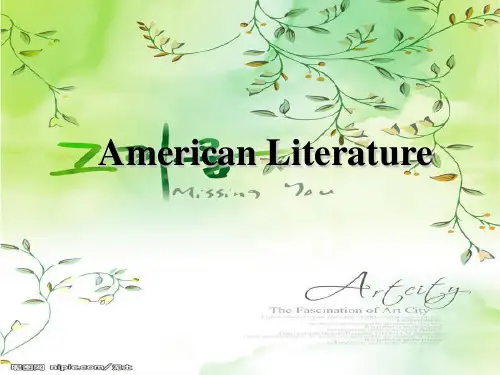
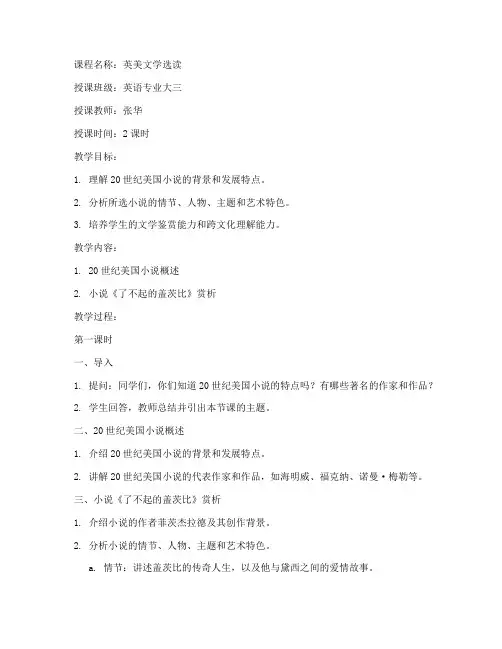
课程名称:英美文学选读授课班级:英语专业大三授课教师:张华授课时间:2课时教学目标:1. 理解20世纪美国小说的背景和发展特点。
2. 分析所选小说的情节、人物、主题和艺术特色。
3. 培养学生的文学鉴赏能力和跨文化理解能力。
教学内容:1. 20世纪美国小说概述2. 小说《了不起的盖茨比》赏析教学过程:第一课时一、导入1. 提问:同学们,你们知道20世纪美国小说的特点吗?有哪些著名的作家和作品?2. 学生回答,教师总结并引出本节课的主题。
二、20世纪美国小说概述1. 介绍20世纪美国小说的背景和发展特点。
2. 讲解20世纪美国小说的代表作家和作品,如海明威、福克纳、诺曼·梅勒等。
三、小说《了不起的盖茨比》赏析1. 介绍小说的作者菲茨杰拉德及其创作背景。
2. 分析小说的情节、人物、主题和艺术特色。
a. 情节:讲述盖茨比的传奇人生,以及他与黛西之间的爱情故事。
b. 人物:分析盖茨比的个性、梦想和悲剧命运。
c. 主题:探讨美国梦的虚幻与破灭,以及人性的复杂。
d. 艺术特色:分析小说的语言、结构、象征手法等。
四、课堂讨论1. 学生分组讨论,分析小说中的主要人物形象。
2. 各组代表发言,分享自己的观点。
第二课时一、复习与回顾1. 复习上节课所学内容,检查学生对20世纪美国小说和《了不起的盖茨比》的理解。
2. 学生回答,教师点评。
二、跨文化理解1. 引导学生思考《了不起的盖茨比》中所体现的美国文化特点。
2. 分析小说中的文化差异,如价值观、生活方式等。
三、总结与拓展1. 总结本节课所学内容,强调20世纪美国小说的重要性和特点。
2. 布置课后作业:阅读《了不起的盖茨比》原著,并撰写一篇读书笔记。
教学评价:1. 学生对20世纪美国小说和《了不起的盖茨比》的理解程度。
2. 学生在课堂讨论中的表现,如分析能力、表达能力等。
3. 学生课后作业的质量。
教学反思:1. 教师应注重培养学生的文学鉴赏能力和跨文化理解能力。
《英美文学》课程教学大纲(本科)-CAL-FENGHAI-(2020YEAR-YICAI)_JINGBIAN《英美文学》课程教学大纲课程编号:04095、04096课程英文名称:British Literature & American Literature学时数:144 学分数:8适用层次和专业:英语专业本科三年级一、课程的性质和目的《英美文学》是我院英语专业高年级学生的专业选修课,本课程的目的在于:培养学生阅读、欣赏、理解英美文学原著的能力,掌握文学批评的基本知识和方法。
通过阅读和分析英美文学作品,促进学生语言基本功和人文素质提高,增强学生读对西方文学知识及文化的了解。
二、课程教学内容及各章节学时分配第一部分英国文学第一章盎格鲁撒克逊时期英国文学(1学时)第一节盎格鲁撒克逊时期文学渊源知识点:该时期的文学流派、代表作家、代表作品第二节《贝奥武甫》的艺术特征及其对英国文学的贡献知识点:该作品中的头韵、含蓄陈述、隐喻等艺术特征、第一部民族史诗对英国文学的影响第二章中世纪英国文学(3学时)第一节中世纪文学概述知识点:文学时期划分、文学特点、代表作家第二节杰佛利·乔叟知识点:生平、创作生涯、《坎特伯雷故事集》的情节、内容、主题《坎特伯雷故事集》节选:语言特点、艺术成就第三节英国和苏格兰民谣知识点:内容、形式、语言特点、代表作品《罗宾汉和埃林阿代尔》:寓意、语言特点第三章文艺复兴时期英国文学(12学时)第一节文艺复兴运动知识点:意大利文艺复兴运动的兴起、人文主义思潮、文艺复兴时期的文学渊源、英国的文艺复兴、宗教改革运动及影响第二节英国文艺复兴时期的文学知识点:伊丽莎白时代的历史文化背景、意大利文学对英国文学的影响、伊丽莎白时代的戏剧、伊丽莎白时代的诗歌第三节文艺复兴时期的主要作家知识点:(1)埃德蒙·斯宾塞生平、创作生涯、代表作品的构思、情节、内容、主题(2)克里斯托夫·马洛生平、创作生涯、著名悲剧、思想艺术成就(3)威廉·莎士比亚生平、戏剧创作生涯、代表作品及其故事梗概、情节结构、人物塑造、语言风格、思想意义、诗歌、艺术成就《威尼斯商人》选段、悲剧《哈姆雷特》选段、十四行诗(18)(4)弗兰西斯·培根生平、主要作品、语言特点、杰出贡献《论学习》的结构、内容、语言特点(5)约翰·邓恩生平、玄学诗派、文学创作、诗歌、散文第四章十七世纪英国文学(4学时)第一节十七世纪的文学概述知识点:十七世纪历史文化背景、十七世纪文学三个时期的划分、十七世纪文学特点第二节十七世纪的主要作家知识点:(1)约翰·弥尔顿生平、文学创作、史诗《失乐园》、主要作品、艺术特点(2)约翰·班扬生平、文学创作、主要作品、艺术特点《天路历程》第一章的主要内容、人物性格、语言特点第五章十八世纪英国文学(12学时)第一节启蒙运动知识点:启蒙运动产生的时代背景、启蒙运动的人文观、启蒙运动的理性准则第二节新古典主义知识点: 新古典主义的创作旨意、新古典主义的文学渊源、新古典主义关于散文、诗歌、戏剧创作的标准第三节新古典主义时期的文学知识点:早期新古典主义诗歌、英国现实主义小说的诞生、哥特式小说与伤感主义文学的兴起第四节十八世纪的主要作家知识点:(1)亚历山大·蒲伯生平、创作生涯、文学观、主要作品、语言风格选读《论批评》节选:作品体裁、结构、语言风格(2)丹尼尔·笛福生平、社会观、主要作品、创作特点《鲁滨逊漂流记》第九章、第十章的主要内容、人物性格、语言特点、作者的创作意义(3)乔纳森·斯威夫特生平、创作生涯、人文观、讽刺散文的语言风格《格列佛游记》第一部分第四章的人物性格、语言特点、作品的主题(4)亨利·菲尔丁生平、戏剧和小说创作活动、对英国小说的贡献、语言特色《汤姆·琼斯》第四部、第八章的人物的刻画、史诗特征(5)塞缪尔·约翰逊生平、创作生涯、主要作品、新古典主义的文学观及语言风格、对英国语言的贡献(6)理查德·比·谢立丹生平、戏剧创作生涯、戏剧的主题、主要作品、写作技巧《造谣学校》第三幕第四场的作品的主题、人物性格、语言特点(7)威廉·布莱克生平、政治宗教观点、诗歌创作主张、主要作品、诗歌的主要特点及思想意义、对20世纪英国文学的影响《伦敦》、《老虎》的主题思想、语言风格、艺术特色等(8)罗伯特·彭斯生平、诗歌创作主张、主要作品、诗歌主要特点及思想意义《一朵红红的玫瑰》的主题思想、语言风格、艺术特色第六章浪漫主义时期英国文学(14 学时)第一节浪漫主义思潮知识点:浪漫主义时期英国社会的历史背景、法国大革命对英国的影响、浪漫主义文学的渊源、浪漫主义文学创作的基本主张、英国浪漫主义文学的特点、浪漫主义文学对同时代及后世英国文学的影响第二节浪漫主义时期的主要作家知识点:(1)威廉·华兹华斯生平及创作生涯、诗歌创作主张、主要作品、诗歌的主要特点及思想意义、诗歌的艺术成就、对同时代及后世英国文学的影响《孤寂的割麦女》、《水仙》、《虹》的主题思想、语言风格、艺术特色等(2)塞•特•科勒律治生平及创作生涯、文学创作主张、哲学思想和文学批评观、主要作品、诗歌的主要特点及思想意义、文学创作及文艺批评思想对同时代及后世英国文学的影响(3)乔治·戈登•拜伦生平及创作生涯、主要诗作、主要特点及社会意义《她行走在美的光影中》的主题思想、语言风格、艺术特色等(4)珀•比•雪莱生平、诗歌创作主张、主要作品、诗歌的主要特点及思想意义、对同时代及后世英国文学的影响《西风颂》、《云雀颂》的主题思想、语言风格、艺术特色(5)约翰•济慈生平及创作生涯、美学思想、主要诗作、诗歌的主要特点及思想意义、诗歌对同时代及后世英国文学的影响《夜莺颂》、《秋颂》的主题思想、语言风格、艺术特色(6)简•奥斯汀生平及创作生涯、小说创作思想、主要作品、小说的主要特点及社会意义、小说对后世英国文学的影响《傲慢与偏见》的故事梗概、主题结构、人物塑造、语言风格及作品的意义第七章维多利亚时代英国文学(12学时)第一节维多利亚时代英国文学及社会思潮概述知识点:早期的经济发展与社会动乱、中期的繁荣昌盛和社会稳定、晚期的势力衰退和社会道德观念的改变、科学发现对传统的社会和宗教观念的影响、功利主义思潮的泛滥第一节维多利亚时期的文学知识点:小说的形式、该时代小说家的共性、散文和诗歌形式、技术方面的实验和创新第三节维多利亚时期的主要作家知识点:(1)查尔斯•狄更斯生平及创作生涯、作品中的批判现实主义思想与社会改良主义倾向、前期作品的思想与艺术特征、后期作品的思想与艺术特征、创作特色与艺术成就《雾都孤儿》第三章、《大卫•科波菲尔》第四章、第五十五章的主题结构、人物塑造、语言风格及作品的意义(2)夏洛特•布朗蒂生平、创作思想和主题、作品的社会意义《简•爱》第二十三章的女主人公形象、在逆境中求自我道德完善的主题(3)埃米莉•布朗蒂生平、、创作主题、对同时代及后世英国文学的影响《呼啸山庄》第十五章的小说的主题、故事的叙述手法、强烈情感的描述(4)阿尔弗雷德•丁尼生生平、诗歌创作生涯、主要作品、艺术特色《渡沙洲》、《尤利西斯》的主题思想、艺术特征(5)罗伯特•布朗宁生平与诗歌创作生涯、主要作品、戏剧独白、艺术特点《我逝去的公爵夫人》、《夜会》、《晨别》的主题思想、艺术特征(6)乔治•艾略特生平及创作生涯、新型小说、女性文学观《织工马南》第二十八章的作品的主题、语言风格(7)托马斯·哈代生平与创作生涯、创作倾向、作品中的“宿命观”、批判现实主义思想、艺术特色《德伯家的苔丝》的作品的主题、人物刻画、语言特色《呼唤》的主题思想、艺术特征第八章二十世纪英国文学(14学时)第一节二十世纪英国文学概述知识点:20世纪英国社会的历史文化背景、两次世界大战对英国的影响、英国20世纪批判现实主义文学、现代主义文学的兴起与衰落、现代主义文学创作的基本主张、英国现代主义文学、英国现代主义文学的特点、现代主义文学对当代英国文学的影响第二节二十世纪的主要作家知识点:(1)乔治·布纳德·萧伯纳生平与创作生涯、政治改革思想和文学创作主张、戏剧创作主张、主要作品、戏剧的特点与社会意义、萧伯纳的戏剧对20世纪英国文学的影响《鳏夫的房产》的主要内容、人物塑造、语言特点、艺术手法(2)约翰•高尔斯华绥生平与创作生涯、创作思想、小说的主要特点及社会意义《福尔塞世家》的主要内容、人物性格、语言特点、叙事手法(3)威廉•勃特勒•叶芝生平及创作生涯、诗歌创作思想、代表作品、诗歌的特点及思想意义、艺术成就、叶芝的诗歌对当代英国文学的影响、戏剧创作《1916年复活节》、《库尔庄园的野天鹅》的语言风格、艺术特色等(4)T•S•艾略特生平及创作生涯、文学理论与文艺批评观点、主要诗歌作品、艺术特色及社会意义、文学创作及文艺批评思想对现当代英国文学的影响《普鲁弗洛克的情歌》的主题结构、思想内容、语言特色、艺术手法(5)戴维•赫伯特•劳伦斯生平及创作生涯、创作思想、主要作品、艺术特色及社会意义、劳伦斯的小说对现当代英国文学的影响《儿子与情人》的主要内容、人物性格、语言特点、艺术手法(6)詹姆斯•乔伊斯生平与创作生涯、文学创作主张与美学思想、主要作品、小说的主要艺术特色及思想意义、艺术成就、作品对现当代世界文学的影响《青年艺术家的肖像》所选作品的主题思想、人物塑造、语言特色、艺术手法(7)弗吉尼亚•伍尔芙生平与创作生涯、意识流小说、其作品和小说理论对英国现代主义小说理论与创作的贡献《达罗卫夫人》的主要内容、表现手法、艺术特征、叙事方式(8)迪伦•托马斯生平与创作生涯、超现实主义的表现手法、其独特的诗歌艺术特征对当代英国诗坛的影响《羊齿山》、《不要温雅地步入那美妙的夜晚》的艺术特征、主题思想(9)菲利普•拉金生平与创作生涯、运动派诗歌、其独特的诗风和诗歌主张对当代英国诗坛的影响《去教堂》的艺术特征和主题思想(10)特德•休斯生平与创作生涯、其动物暴力诗的艺术特征和主题思想《栖息之鹰》的艺术特征和主题思想(11)西默斯•希尼生平与创作生涯、其作品纯美的语言风格和鲜明的爱尔兰民族色彩《沼泽地》的艺术特征和主题思想第二部分美国文学Part One (4 periods)The Colonial Period and The17th Century Literature of Puritanism1. Historical Backgroundi. Religious Cause: Puritanism / Puritan thoughtsii. Economic ones:2. Development of Literaturei. Characteristicsii. Authors: William Bradford, Anne Bradstreet, Edward TaylorPart Two (4 periods)The Period of Enlightenment1. Historical Backgroundi. American revolutionii. The age of reason2. Development of Literaturei. Benjamin Franklin: Autobiographyii. Philip FreneauPart Three (20 periods)New England Transcendentalism and Romantic AgeA. Period of Pre-Romanticism1. Historical BackgroundTranscendentalism2. Development of Literaturei. Romanticism3.Major WritersWashington Irving: Rip Van winkleB. Period of Post-Romanticism1. Historical Backgroundi. Civil Warii. Anti-slavery movement2. Development of Literature3. Major Writersi. Edgar Allen Poe: To Helenii. Ralph Waldo Emerson: Natureiii. Walt Whitman: Songs of Myselfiv. Nathaniel Hawthorne: The Scarlet Letterv. Henry Wadsworth Longfellow: A Psalm of Lifevi. Emily DickinsonPart Four (16 periods)The Age of Realism1. Historical BackgroundThe Gilded AgeNew England Renaissance2. Development of Literaturei. Realism: definitions & Characteristicsii. Realism vs romanticismiii. Practitioners: William Dean Howells, Henry James, Mark Twain 3. Major WritersMark Twain: The Adventures of Huckleberry FinnPart Five (12 periods)American Naturalism1. Historical Backgroundi. The First World Warii. The Jazz ageiii. Commercialized society2. Development of Literaturei. Naturalism: definitions & Characteristicsii. Practitioners: Stephen Crane, Frank Norris, Jack London, etc.3. Major WritersTheodore Dreiser: Sister CarrieRobert Frost: Stopping by Woods on a Snowy EveningPart Six (8 periods)American Modernism1. Historical Backgroundi. Great depressionii. The Second World War2. Development of Literaturei. Modernism: definitions & Characteristicsii. Lost Generation: Ernest Hemingway, Ezra Pound, e. e. cummings etc.3. Major WritersErnest Hemingway: A Farewell to ArmsJohn Steinbeck: The Grapes of WrathWilliam FaulknerPart Seven (8 periods)American Literature Since 19451. Historical Backgroundi. Political Situation: Cold War, Korean War, Cuban missile crisis, Vietnam War etc.ii. Ideological Development2. Development of Literaturei. The Beat Generation: Allen Ginsberg etc.ii. Jewish writers: Saul Bellow etc.iii. Black American Literature3. Major WritersSaul BellowAllen GinsbergAlice Walker三、课程教学基本要求在教学中应该使学生对英美文学形成与发展的全貌有一个大概的了解;通过指导学生阅读具有代表性的英美文学作品,理解作品的内容,从而掌握分析作品的艺术特色和评价文学作品的方法。
课程名称:大学英美文学授课对象:大学一年级学生课时:2课时教学目标:1. 了解英美文学史的基本脉络和发展阶段。
2. 掌握英美文学史中的重要作家和作品。
3. 培养学生对英美文学的兴趣和审美鉴赏能力。
教学重点:1. 英美文学史的发展阶段。
2. 重要的英美文学作家和作品。
教学难点:1. 英美文学史的发展脉络与特点。
2. 如何理解不同时期的文学作品。
教学准备:1. 教师准备PPT课件,包括英美文学史发展阶段、重要作家和作品介绍等。
2. 学生预习相关英美文学史资料,了解文学史的基本知识。
教学过程:第一课时一、导入1. 教师简要介绍英美文学的起源和发展。
2. 引导学生思考:为什么英美文学在全球范围内具有广泛的影响力?二、讲授新课1. 英美文学史发展阶段:a. 古典时期:介绍英国文学的起源,如史诗、戏剧等。
b. 文艺复兴时期:介绍莎士比亚等作家的作品,如《哈姆雷特》、《罗密欧与朱丽叶》等。
c. 启蒙时期:介绍笛福、斯威夫特等作家的作品,如《鲁滨逊漂流记》、《格列佛游记》等。
d. 浪漫主义时期:介绍拜伦、雪莱等作家的作品,如《唐璜》、《西风颂》等。
e. 现实主义时期:介绍狄更斯、勃朗特姐妹等作家的作品,如《双城记》、《呼啸山庄》等。
f. 现代主义时期:介绍詹姆斯·乔伊斯、弗吉尼亚·伍尔夫等作家的作品,如《尤利西斯》、《到灯塔去》等。
2. 重要的英美文学作家和作品:a. 莎士比亚:介绍其生平、代表作及艺术成就。
b. 查尔斯·狄更斯:介绍其生平、代表作及文学价值。
c. 弗吉尼亚·伍尔夫:介绍其生平、代表作及文学风格。
三、课堂讨论1. 学生分组讨论:选择一个喜欢的文学时期或作家,分享自己的观点和感受。
2. 教师点评并总结。
第二课时一、复习导入1. 教师提问:上节课我们学习了英美文学史的发展阶段和重要作家,请同学们回顾一下。
2. 学生回答,教师点评。
二、讲授新课1. 英美文学史的特点:a. 跨越时空的文学现象。
英美文学选读---权威讲义English LiteratureIntroduction :The old and Medieval English literature.*****A. The old English literature1.The time period :The period of Old English literature extends from about 450 to 1066.2.The classification of the old English poetry :The old English poetry can be divided into two groups : the religious group and the secular one .a.)The religious group is mainly on biblical themes.b.)The secular group concludes;The national epic poem , Beowulf ,and lyrical poems of shorter length .3.The representative of this period : Beowulf .a.)The natureBeowulf is regarded today as the national epic of the Anglo-Saxons.b.)The settingThe story took place in Scandinavia.c.)The theme:The poem presents a vivid picture of how the primitive people wage under a wise heroic struggles against the hostile forces of the natural world under a wise and mighty leader .d.)The significance :The poem is an example of the mingling of nature myths and heroic legends. The battle between Beowulf and the Dragon Symblically represent that phrase of Winter and Summer myth in which the Summer God,here embodied by Beowulf .******B. The medieval English literature1.The time period : From 1066 up to the mid-14th century.2.The classification of the medieval English Literature: Middle English literature deals with a wider range of subjects.a.)popular folk literature also occupies an important place in this period .b.)Romance which uses narrative verse or prose to sing knightly adventures or other heroic deeds is a popular literary form in the Medieval period .3. The representative of this period : Chaucer and the Canterbury tales.a.)The influence of Renaissance :The influence of Renaissance was already felt in the field of English literature when Chaucer was learning from the great Italian writers like Petrarch and Boccaccio.1)Chaucer introduced from France the rhymed stanzas to replace the old English alliterative verse.2)In the Romaunt the Rose , he fixst introduced into English the octosyllabic couplet.3)In The Legend of Good Women , he used for the first time in English the rhymed couplet of iambic pentameter.And in The Canterbury Tales , Chaucer employed the heroic couplet with true ease.4)Chaucer also developed the art of literature itself . In Troilus and Criseyde, he gave the world what is virtually the first modern novel .5)In The Canterbury Tales , he developed his art of poetry still further towards drama and the art of novel. John Dryden, called Chaucer the father of English peotry . For the Renaissance , he was the English Homer.======================================================================Chapter 1The Renaissance Period (文艺复兴时期)本章概述一. 文艺复兴运动和人文主义思想产生的历史, 文化背景;二. 文艺复兴时期文学创作的基本特征和基本主张;三. 文艺复兴时期的哲学与文艺理论对同时代及后世英国文学与文化的影响.四. 主要作家与作品.文学史分析******* A. The time periodThe Renaissance marks a transition from the medieval to the modern word . It refers to the period between the 14th and mid-17th centuries .****** B. The definition of Renaissance :a. The birthplace : In Italyb. The meaning : The Renaissance means rebirth or revival .c. The nature : The Renaissance ,in essence , is a historical period.****** c. The theoretical basis of the Renaissance :1. The essence of the Renaissance :a.) The sourceHumanism is the essence of the Renaissance , It sprang from the endeavor to restore a medieval reverence for the antique authors .b.) The basis of the Humanism .it was based on such a conception that man is the measure of all things .2.The representative :a. The symbol :Humanism began to take hold in England when the Dutch scholar Desiderius Erasmus came to teach the classical learningb. The major representatives :Thomas More , Christopher Marlowe and William Shakespeare are the best representatives of the English humanists .********* D. The cultural Background of the Renaissance :1. The national feeling :Strong national feeling in the time of the Tudors gave a great incentive to the cultural development in England . English schools and universities were established in place of the old monasteries .2. The introduction of printing :William Caxton Introduced printing into England . In this lifetime ,Caxton printed about one hundred books in English .3. The emergence of an age of translationWith the introduction of printing , an age of thranslation came into being .4. The significance :The introduction of printing led to a commercial market for literature , making everything ready for the appearance of the great Elizabethan writers.********* E. The literature forms during the Renaissance :1. The poetrya. The feature :The first period of the English Renaissance was one of imitation and assimilation .1.) petrarch was regarded as the fountain head of literature by the English writers .2.) Wyatt introduced the petrarchan sonnet into England .3.) Surrey brought in blank verse.4.) Sidney followed with the sestina and terza rima5.) Marlowe gave new vigor to the blank verse with his "mighty lines. "b. The representatives :1.) Spenser's The Shepheardes Calender showed the pastoral convention .2.) In " The Passionate Shepherd to His Love . " Marlowe spoke that it would be very difficult for us to connect it with the voice in his tragedies .3.) Poetry and Poetic drama were the most outstanding literary forms and carried on by Shakespeare and Ben Johnson .2. The dramaA.) The feature :The Elizabethan drama is the real mainstream of the English Renaissance . English material was put into the regular form of the Latin comedies of Plautus and Terence . Tragedies were in the style of Seneca .B.) The representative dramatists :The most famous aramatists are christopher Marlowe , William Shakespeare , and Ben Johnson.3.The essays :A.) The representatives essayist :B.) The influence :Bacon was also the founder of modern science in England , His writings pave the way for the use of scientific method .主要作家作品埃德蒙*斯宾塞一. The masterpiece : The Faerie Queene .1. The intention and the structureA.) The intentionThe principal intention is to present through a "historical poem " the example of perfect gentleman .B) The structure:There are 12 virtues of the perfect gentleman ,and plans 12 books , each one with a different hero distinguished for one of the private virtues .2. The unifying element :A.) The recurring appearances of Arthur serve as a unifying element for the poem as whole .B.) Another character contributing to the unity of the work is Gloriana.3. The allegory :The Redcross knight in Book I stands for st. George , he also represents Holiness.4. The themeThe theme is not "Arms and the man ," but something more romantic ----"Fierce Wares and faithful loves . "二. The poetic features :1. The five main qualities :The five main qualities of Spenser's are : 1.) a perfect melody ;2.) a rare sense of beauty;3.) a splendid imagination ;4.) a lofy moral purity and seriousness5.) a dedicated idealism2. In addition :Spenser uses strange forms of speech and obsolete words , His exquisite melody that make him known as " the poet's poet . "克里斯托夫*马洛一. The works :1. The play : ( 6 plays )2. The non-dramatic poetry.3. The verse translation .1. Tamburlaine :A. The outline :Tamburlaine is a play about an ambitious and pitiless Tartar conqueror in the fourteenth century who roes from a shepherd to an overpowering king .B. The intention :By depicting a great hero with high ambition and sheer brutal force , Marlowe voiced the supreme desire of the man of the Renaissance for infinite power and authority .2. Dr. Faustus :A. The outline :Dr. Faustus is a play based on the German legend of a magician aspiring for knowledge and finally meeting his tragic end as a result of selling his soul to the Devil .B. The intention :It celebrates the human passion for knowledge, power and happiness ; it also reveals man's frustration .三. The artistic achievements1. The stylistic features :A. Marlowe perfected the blank verse and brought vitality and grandeur into the blank verse with his "Mighty lines . "B. Marlowe employed hyperbole as his major figure of speech .2. The characters and the humanistic ideal :A. Marlowe ' s second achievement is his creation of the Renaissance hero for English drama . Such a hero is always individualistic and full of ambition.B. He embodies Marlowe's humanistic ideal of human dignity and capacity . with the endless aspiration for power, knowledge , and glory , the hero interprets the true Renaissance Spirit .威廉*莎士比亚一. The dramatic career : (4 periods )1. Apprenticeship period2. High individualized period3. Greatest stragedies and dark comedies period .4. Romantic tragicomedies period .二. The themes of Shakespeare's works1. The history plays :A. The themeShakespeare's history plays are mainly written under the principle that national unity under a mighty and just sovereign is a necessity .Henry VI (I,II, III ) are the beginning of Shakespeare's epic treatment of English history . Henry IV (I,II,III) are undoubtedly the most widely read among his history plays .2. The romantic comedies :A . The theme :On his romantic comedies , Shakespeare takes an optimistic attitude toward love and youth , and the romantic elements are brought into full play .The example :The important play among the comedies is the Merchant of Venice .a. The traditional theme :The traditional theme of the play is to praise the friendship between Antonio and Bassanio, to idealize Portia as a heroine of great beauty , wit and loyalty , and to expose the insatiable greedand brutality of the Jew .b. The modern theme :Many people today tend to regard the play as a satire of the Christian's hypocrisy and their false standards of friendship and love , their cunning ways of pursuing worldiness and their unreasoning prejudice against Jews .3. The tragedies :A . The theme :The play , though a tragedy , is permeated with opitimistic spirit .B. The example :The successful romantic tragedy is Romeo and Juliet, which eulogizes the faithfulness of love and the spirit of pursuing happiness .三. The greatest tragedies :1. The common features :Shakespeare 's greatest tragedies are : Hamlet , Othello , King Lear , and Macbeth . They have some characteristics in common . Each portrays some noble hero , who faces the injustic of human life and is caught in a difficult situation and whose fate is closely connected with the fate of the whole nation .2. The realistic spiritsAlong with the portrayal of the weakness or bias of the hero , we see the sharp conflicts between the individual and the evil force in the society , which shows that Shakespeare is a great realist in the true sense .3. The analysisA. Hamlet :a. Hamlet , the first of the great tragedies , is generally regarded as shakespeare's most popular play on the stage .b. Hamlet has none of the single-minded blood lust of the earlier revengers . It is not because he is incapable of action , but because the cast of his mind is so speculative , so questioning , and so contemplative that action .c. His life is one of constant role-playing , examining the nature of action only to deny its possibility .d. By revealing the power-seeking , the jostling for place , shakespeare condemns the hypocrisy and treachery and general corruption at the royal court .B. The Tempest :a. The Tempest , an elaborate and fantastic story , is known as the best of his final romances .四. The artistic achievements :1. The characters :A. Shakespeare's major characters are neither merely individual ones or type ones .B. By applying a psyche-analytical approach , Shakespeare succeeds in exploring the characters' inner mind .C. Shakespeare also portrays his characters in pairs . Contrasts are frequently used to bring vividness to his characters .2. Construction :A. Shakespeare's plays are well-known for their adroit plot construction . He borrows them from some old plays or storybooks , or from ancient Greek and Roman sources .B. He would shorten the time and intensify the story . There are usually several threads running through the play .3. Language and style :A. Irony is a good means of dramatic presentation . Disguise is also an important device to create dramatic irony , usually with woman disguised as man .B. He has an amazing wealth of vocabulary and idiom . His influence on later writers is immeasurable . Almost all English writers after him have been influenced by him either in artistic point of view , in literary form or in language .弗朗西斯*培根一. The worksHis works can be divided into three groups .1. The philosophic groups .2. The literary groups .3. The law groups .二. The masterpieces :1. The Advancement of Learning :A. The theme :The Advencement of Learning is a great tract on education .B. The contents :In Book I , Bacon highly praises knowledge . He divided knowledge into two kinds . One is from the Divine Revelation , the other i sfrom the workings of human mind . The second book is a survey of learning , According to Bacon , man's understanding consists of three parts : history to man's memory , poetry to man's imagination and creation and philosophy to man's reason .2. Novum Organum :A. The theme :Novum Organum is a successful treatise written in Latin on methodology .B. The contents :is the most impressive display of Bacon 's intellect . The argument is for the use of the inductive method of reasoning in scientific study , In the scond book , Bacon suggest the industive reasoning .A. The sources :Montaigne is the predecessor of Bacon . The term "essay "was borrowed from Montaigne's Essais .B. The comparison with Montaigne's :They are totally unlike in temperament . outlook and writing style . Montaigne's essays show a strong personal touch . Bacon , as a practical and prudential man , intends to write for the ambitious Elizabethan and Jacobean youth of his class and tell them how to be efficient and make their way in public life . Of the fifty-eight essays in its final edition , more than half are about public life or public duty .C. Bacon's styles :Bacon's essays are famous for their brevity , compactness and powerfulness . The essay are well-arranged and enriched by Biblical allusions , Metaphors and Cadence .约翰*邓恩一. The metaphysical poetry :The tern "Metaphysical peotry " is commonly used to name the work of the 17th -century writers who wrote under the influence of John Donne .1. The themeThe metaphysical poets tried to break away from the conventional fashion of the Elizabethan love poetry .2. The language :The diction is simple , and echoes the words and cadences of common speech .3. The imagery :It is drawn from the actual life .4. The form :It is frequently the form of an argument with the poet'sbeloved , with God , or with himself .二. The characteristic of Donne's works :1. The inherently theatrical impression :John Donne is the leading figure of the "metaphysical school . " His poems give a more inherently theatrical impression .2. The poetic mode :The mode is dynamic rather than static ,with ingenuity of speech , vividness of imagery and vitality of rhythms.3. The stylistic features :The most striking feature of Donne's poetry is precisely its tang of reality , in the sense that it seems to reflect life in a real rather than a poetical world .三. The masterpieces1. The songs and sonnets :A. The themeThe songs and Sonnets , contains most of his early lyrics , Love is the basic theme .B. The understanding of love :Donne holds that the nature of love is the union of soul and body . This though is quite contrary to the medieval love idea . What is love , idealism and cynicism about love coexist in Donne's love poetry . he sometimes expresses the fufility and instability of love in his poems .C. The stylistic method :When eulogizing a woman ,Donne tells us very little about her physical beauty . Instead , Donne's interest lies in dramatizing and illustrating the state of being in love .2. The Holy sonnets :A. The theme:Donne's chief power as a religious poet is shown in the HolySonnets .B. Contents :In A Hymn to God the Father do we find a an assured faith .The best of the Holy Sonnets express these strugles with unparalleled force .四. The Artistic features1. The conceits :In his poetry , Donne frequently applies conceits , his conceits may be divided into two kinds ; easy ones and difficult ones . By combining the easy conceits with the difficult ones , Donne achieves surprising good effects in his poetry .2. the argument :Donne's poetry involves a certain kind of argument , sometimes in rigid syllogistic form . with the brief . Simple Language , the argument is continuous throughout the poem .3. The imagination :Donne's great prose works are sermons , which are both rich and imaginative . some of Donne's sermons are carefully contrived with a dramatic . And it is the obsession with death that characterizes Donne's nature religious works .约翰*弥尔顿Milton 's literary achievements can be divided into three groups .1. The early works :Milton appears as the inheritor of all that was best in Elizabethan literature . Lycidas is a typical example .2. The middle works :His powerful pamphlets written during this period make him the greatest prose writer of his age .3. The last great poems :Milton wrote his three major poetical works : Paradise Lost , Paradise regained and Samson Agonistes .二. The masterpieces :1. paradise Lost :A. The theme and structure :Paradise Lost is a long epic divided into 12 books .The theme is the "Fall of Man ".B. The humanistic spiritsa. Working through the tradition of a Christian humanism , Milton wrote Paradise Lost intending to expose the way of Satan and to "justify the ways of God to man . "b. At the center of the conflict between human love and spiritual duty lies Milton's fundamental concern with freedom and choice .c. The freedom of the will is the keystone of Milton's creed .2. Paradise Regained :A. The content :Paradise Regained shows how mankind , in the person of Christ , withstands the tempter and is established once more in the divine favor .B. Theme :Christ's temptation in the wilderness is the theme .3. Samson Agonistes :A. The source :In samson Agonistes , Milton again borrows his story from the Bible . But this time he turns to a more vital and personal theme .B. The purpose :The poet's aim was to present on English a pure tragedy , with all the passion and restraint .The neoclassical period(新古典主义时期)本章概述一. 启蒙运动与新古典主义文学流派产生的历史背景.二.新古典主义文学的主要特征与基本主张.三. 对同时代与后世英国文学的影响.四. 主要作家与作品The Neoclassical Period文学史分析一. The time period :The neoclassical period is between the return of the students in 1660 and the full assertion of Romanticism which came with the publication of Lyrical Ballads in 1798 .二. The Age of Elightenment :1. The outline :A. The definition :The eighteenth -century England is also known as the Age of Enlightenment or the Age of Reason . The Elightenment Movement was a progressive intellectual movement .B. The source :It flourished in France and swept through the whole Western Europe at the time .C. The nature :The movement was a furtherance of the Renaissance of the fifteenth and sixteenth centuries .D. The purpose :Its purpose was to enlighten the whole world with the light of mordern philosophical and artistic ideas .2. The rational principle :A. principles :The enlighteners celebrated reason or rationality , equality and science . They held that rationality or reason should be the only , the final cause of any human thought and activities .B. The significance :It provided theory for the French Revolution of 1789 and the American War of Independence in 1776 .C. The humanistic ideas :The enlighteners advocated universal education . They believed that human beings were limited , dualistic , imperfect , and yet capable of rationality and perfection through education.3. The literature featrues :literature at the time , heavily didactic and moralizing , became a very popular means of public education .三. The literature forms :The sentimental Literature :A. The background :In the last few decades of the 18th century . however , the neoclassical emphasis upon reason, intellect , wit and form was rebelled against or challenged by the sentimentalists , an was gradually by Revolution and a symbol of the growing importance and strength of the English Middle class .4. The Gothic novels :A. The background :From the middle part to the end of the century there was also an apparent shift of interest in literature creation .B. The fetures :Gothic novels ---mostly stories of mystery and horror which take place in some haunted or dilapidated Middle Age Castles ---were turned out profusely by both male and female writers .5. Others :Eulogizing or lamenting lyrics ; The romantic poems ; the theatrical world ; the witty and satiric prose .主要作家作品A. 约翰*班扬B.亚力山大*蒲伯C. 丹尼尔*笛福D. 乔纳森*斯威夫特E. 亨利*费尔丁F. 塞缪尔*约翰逊G. 理查*比*谢立丹H. 托马斯*格雷约翰*班扬一. Literature styles :2. He used concreted and living language and vivid details .3. He made it possible for the reader of the least education to share the pleasure of reading his novel .二. The worksGrace Abounding to the Chief of Sinners ,The Life and Death of Mr.Badman , The Holy War and The pilgrim's progress , (Part I , II )三. Selected Reading : The Vanity Fair .1. The imagery :A. The pilgrim's Progress is the most successful religious allegory in the English language . Its purpose is to urge people to abide by Christian doctrines with their own weakness and all kinds of social evils .B. Its predominant metaphor --life as a journey --is simple and familiar .2. The features :A. The strange is combined with the familiar and the trivialjoined to the divine.B. A rich imagination and a natural talent for storytelling also contribute to the success of the work .亚力山大*蒲伯一. The thoughts :1. The view of realism :A. He upheld the existing social system as an ideal one , but he was not entirely blind to the rapid moral , political and cultural deterioration .B. He assumed the role of champion of traditional civilization , but for him the supreme value was order .2. The view of Criticism :A. He published The Rape of the Lock and use the mock epic form to retell the cutting of the lock , to ridicule the trivial incident and to satirize the foolish , meaningless life of the lords and ladies in the aristocratic bourgeois society of the eighteenth century England .B.The Dunciad , generally considered Pope's best satiric work , is directed at Dullness in general . Dullness as reflected in the corruptness of government ,social morals , education and even religion , is expertly exposed and satirized .二. The Artistic feature :1. He strongly advocated neoclassicism .2. He worked painstakingly on his poems , developed a satiric concise , smooth , graceful and well-balanced style .3. He finally brought to its last perfection the heroic couplet .1. The chief works : An Essay on Griticism , The Rape of the Lock , The Dunciad , An Essay on Man .2. The translations of Homer's Iliad and Odyssey .3. The edition of shakespeare 's plays .丹尼尔*笛福一. The works1. The first novel : Robinson Crusoe2. four other novels :Captain Singleton , Moll Flanders , Colonel Jack and Roxana .3. The pseuda-factual account of Great plague : A Journal the Plague Year .二. The masterpieces :1. Robinson Crusoe:Robinson Crusoe , an adventure story very much in the spirit of the time , is universally considered his masterpiece .2. The rest four nevels :His rest four novels deal withthe personal history of some hero or heroine . The group of four novels clearly manifests Defoe's deep concern for the poor and the unfortunate in his society . They are the first literary works devoted to the study of problems of the lower-class peoplel三. The Artistic features :1.The realistic novels :A. Defoe spoke for and to the members of his dass and his novels enjoyed great populatity amony the less cultivated .B. In most of his works , he gave his praise to the hard - working , study middle class and showed his sympathy for the downtrodden , unfortunate poor.2. The language feature :A. He had a gift for organizing minute details .B. His sentences are sometimes short , crisp and plain , and sometimes long and rambling .c. His language is smooth ,easy , colloquial and mostly vernacular .四. Selected Reading : Robinson crusoe1.The outline :The novel consists actually of three parts though only the first part is most well-known and widely read . In this part the hero of the story , Robinson Crusoe , narrates in the first person his stories .2. The hero:A. In Robinson Crusoe , Defoe traces the growth of Robinson from a nave and artless youth into a shrewd and hardened man .B. Robinson is here a real hero : a typical eighteenth-century English middle-classman .C. He is the very prototype of the empire builder . the pioneer colonist . In describing Robison 's life on the island , Defoe glorifies human labor and the Puritan fortitude .乔纳森*斯威夫特一. The works :1. The works to establish his name :A Tale of a Tub and The Battle of the Books established his name as a satirist .2. The letters of Drapier :He published ,under the pseudonym of Drapier , a series of letters . Eventoday Swift still respected as a national hero in Ireland .3. The greatest satiric work:He wrote and published his greatest statiric work , Gulliver's Travels .二. The aritistic features :1. The master satirist :A. Swift is a master satirist . His satire is usually masked by an outward gravity and an apparent earnestness .B. His "A Modest Proposal " is generally taken as a perfect model .2. the master of English prose :A. Swift is one of the great masters of English prose , His writing is simple , direct , precise prose . He defined a good style as "proper words in proper places . "B. Clear , simple , concrete diction , uncomplicted sentence structure , economy and conciseness of language mark all his writings .三. Selected Reading : Gulliver's Travels1. Gulliver's Travels , Jonathan's best fictional work . The book contains four parts :His experience in Lilliput , Alone in Brobbingnay , visit to the Flying Island and Account of his discoveries in the Houyhnhnm land . In structure , the four parts make an organic whole .2. Gulliver give an account of some aspects of Lillipution life and obviously alludes to the similar ridiculous practices or tricks of the English government .亨利*费尔丁一. The works :1. The playsFielding had attempted a considerable number of forms of plays :witty comedies of manners , farces or ballad operas , and burlesques or satires .B.The best known plays :The best known are The Coffee-House Politiciam , The tragedy of trgedies , pasquin , and The Historical Register for the Year 1736 .2. The novels :A.The first novel :。
Unit 4 Nathaniel HawthorneI. Life storyII. Literary worksIII. ThemeIV. Points of viewV. StyleVI. SignificanceVII. The Scarlet LetterI. Life StoryNathaniel Hawthorne (1804-1864) was a novelist and short story teller. He was born on July 4, 1804 in Salem, Massachusetts. Some of his ancestors were notorious for the persecution of the Quakers and for the Salem Witchcraft Trial in 1692. The family fortune declined gradually. His father died when he was four years old. With the support of his relatives, Hawthorne entered Bowdoin College to study, where he made friends with the poet Longfellow and Franklin Pierce, the 14th U.S. President. After graduation in 1825, he returned to Salem and pursued his literary dream.II. Literary Works1. Collections of short stories:Twice-Told TalesMosses from an Old Manse—“Young Goodman Brown”—“The Minister’s Black Veil”2. The Scarlet Letter ★★★3. Other novels:The House of the Seven GablesThe Blithedale RomanceThe Marble FaunIII. Theme1. New England regional past and American past2. Secret guilt and evil3. Alienation and solitude4. Original sin and its influence5. Compl exity of human psychology; “interior of the heart”IV. Points of View1. Evil is at the core of human life. Hawthorne has a “black” vision of life and human beings.2. Whenever there is sin, there is punishment. Sin or evil can be passed down from generation to generation.3. He believes that evil educates.4. He has disgust in science.V. Style1. The use of symbolism2. Revelation of character’s psychology3. The use of supernatural mixed with the actual4. Allegory—to teach or preach5. The use of ambiguity to keep the reader in the world of uncertaintyVI. Significance1. He was a master of psychological insight.2. He was a very important moralist novelist in the 19th century.3. His original writing style profoundly influenced his contemporary writers and some other American writers after him.VII. The Scarlet LetterThe Scarlet Letter is Hawthorne’s best-known novel. The story is about the love tragedy between Hester Prynne and Reverend Arthur Dimmesdale. Prynne is a young married woman, but her husband get lost on their journey to the New World. She falls in love with Dimmesdale and gives birth to a daughter, whose name is Pearl. Then she is forced to wear the scarlet letter “A”, which stand s for “Adultery”. She accepts the punishment, but refuses to reveal her lover’s identity. Eventually, Dimmesdale admits his part in the adultery and dies in Prynne’s arms. In these years, Prynne changes the original meaning of the scarlet letter by treating others with kind ness.Symbolic meanings in this novelThe sy mbolic meaning of the scarlet letter “A” changes as the story goes on:A symbol of Adultery↓A symbol of angel↓A symbol of able\abilityAll these four characters are symbols. They are typical examples of all people in the society and their relationships include all the major relationships in the human society.Hester Prynne: truth, love and beautyDimmesdale: a split personality, hypocrisyChillingworth: wickedness, darkness, hatred, evil, defect in human personalityPearl: hopeUnit 5 Herman MelvilleI. Life storyII. Literary worksIII. ThemeIV. StyleV. ReputationVI. Moby DickI. Life storyHerman Melville (1819-1891) is a novelist and poet. He was born in New York City on August 1, 1819. His father died in 1832. Melville droppe d out of school shortly after his father’s death and went to work at the age of fifteen in a variety of trades, such as bank clerk, salesman, farmhand and school teacher. In 1839 he decided to become a seaman, first in a merchant ship and then a whaling ship to the South Seas. Melville used his sea experience in a number of his novels. He returned to America in 1844, and began to write. In 1850, he met Hawthorne and was deeply influenced by Hawthorne. His early adventure stories made him popular for a while, but his later novels were not favored by readers in his time. He died in 1891 humbly.II. Literary works1. Novels:TypeeOmooMardiRedburnWhite JacketMoby Dick ★★—Melville’s masterpiece, a significant philosophical w ork on spiritual explorationPierreThe Confidence ManBilly Budd2. Collections of Poems:Battle PiecesClarelJohn Marr and Other SailorsTimoleonIII. Theme1. Alienation (far away from each other)2. Loneliness3. Suicidal individualism (individualism causing disaster and death)4. Rejection and quest5. Confrontation of innocence and evil6. Doubts over the comforting 19th-century idea of progressIV. Style1. The use of symbolism and allegory2. Ambiguity through employing the technique of multiple view of his narratives.3. Rhythmical prose and his poetic powerV. ReputationDuring his own lifetime, Melville was known as an adventure writer. Even his masterpiece Moby Dick was not well received at its publication. He was rediscovered in 1920s. Nowadays, he is regarded as great as Whitman, and Faulkner. His Moby Dick is recognized as one of the greatest American novels. He is the writer who creates the first American prose epic, Moby Dick.VI. Moby DickMoby Dick is one of th e world’s greatest masterpieces. It is a sea adventure, an exciting chase after a destructive and mysterious creature. Captain Ahab has lost a leg in a previous encounter with the enormous white whale named Moby Dick, so he is eager to find and kill the wh ale. At the novel’s end, Ahab finds and attacks the whale, but the terrible whale takes Ahab, his ship Pequod, and nearly all its crew down to the watery grave with him. Only one of the crew named Ishmael survives to tell the story.Symbolic Meaning in Moby DickThe White Whale, Moby Dick:It symbolizes nature. It is complex, unfathomable, malignant, and beautiful as well.For Captain Ahab, the whale represents evil. Ahab asks the whole crew on the Pequod to join him in the pursuit of the big whale in order to root out the evil, but only to be destroyed by the evil, by his own burning desire, and by his madness. He becomes evil himself in his thirst to destroy the evil.For author, as well as the reader and Ishmael, Moby Dick is still a mystery, an ultimate mystery of the universe, inscrutable and ambivalent, Symbolic Meaning in Moby DickThe Ship Pequod:Pequod is the name of an Indian tribe, which has disappeared in the world forever. Therefore, the ship is doomed to be destroyed.In the novel, it is a microcosm of human society.The V oyage:The voyage becomes a search for truth and knowledge in the novel.From the novel, we can find Melville has a different opinion with Emerson. While Emerson believes man has the ability to discover Nature, Melville holds that it is destructive for human beings to discover Nature.Assignment1. Suggested reading list:Hawthorne’s The Scarlet LetterMelville’s Moby Dick2. homework:Preview next unit.。
英美文学选读串讲讲义 Standardization of sany group #QS8QHH-HHGX8Q8-GNHHJ8-HHMHGN#《英美文学选读》应考指导一、教材说明《英美文学选读》是全国高等教育自学考试英语专业本科段的必修课程,也是广大考生比较头疼的课程。
教材大体可以分为两个大的部分,文学发展史和作家介绍及作品选读。
让考生头疼的事情是课本信息量太大,考纲要求的内容较多,学习的时候理不出头绪,也不便记忆。
事实上,文学课有着相当强的逻辑性和系统性,只要我们把握住这一点,这门课程并不难学,也不难考过。
二、考情分析2009年,本门课程的考试大纲做了一些调整,这种调整在某种程度上减轻和考生的复习负担,但也同时考察的内容更细,更全。
(一)关于考核要求的调整考核要求中每章概述内容不作调整;“该时期的重要作家”只包含对考核知识点中保留的重要作家的相关内容的考核。
(二)大纲调整后的特点(1)新大纲更加突出了英美各个文学时期的时代特点。
如:文艺复兴时期的戏剧和诗史,浪漫主义时期的诗歌等。
从这个意义上讲,命题的重点突出了。
(2)新大纲中考核的作家,都是每一个文学时期文学潮流的最具代表性的作家,都是对该时期文学的发展起到决定作用的作家。
从这个意义上讲,命题的焦点集中了。
(3)新大纲中所保留的作家的作品大多是广大考生耳熟能详的作品,从这个意义上讲,考试的难度降低了。
三、复习方法(一)概述:考试大纲调整以后,可命题的作家的数量减少了,但命题的深度会增加;同时,由于作家数量的减少,这也意味着在每一章的概述部分和作品选读部分的命题点会增多。
(二)每章概述部分的复习重点在对这部分的复习中,重点关注每一个文学时期的界定以及其标志性事件;另外每一个文学时期的时代特点和突出文学成就也是考查的重点,还有本时期同时存在的文学流派的特点也是重点内容。
(三)每章重点作家的复习重点作家的文学史上的地位和贡献;作家的代表作以及代表作的中心大意和所反映的社会现实;作家的写作风格和写作特点也是命题的重点。
5.1真题分析2、第2本书《美国文学简史》:5.3重点知识点汇总分析(大纲)第七部分大学英语语言文学专业英美文学与中文作文基础知识点框架梳理及基础阶段,复习时间是从5月份至9月份或10月份,这一阶段需要大家认真看完《英国文学史》与《美国文学史》,理清文学史的线索,例如文学史的大致分期,每一阶段的大致时间,社会背景,思想背景及每一阶段的代表人物及其代表作。
文学史这两本书每本至少看两遍。
文学史的复习方法主要以熟悉知识点为主,脑海中线索清晰,重点部分最好能在理解的基础上识记。
文学史的复习时应注意归纳总结出一下内容:●英美文学史的大致分期(整合标题)、每一时期大致的时代背景及思想特征.●记住每一时期最重要的作家及作品,知道文学的基本常识,例如文学术语。
●主要作品的故事情节,主要人物,人物形象,主题思想,作品评价。
A Survey of English History ChangYaoxinA Glossary of Literary Terms:For the convenience of discussion, historians divide the continuity of English literature into segments of time which are called “p eriods”. The e xact numbers, dates and names of these periods vary, but the list below conforms on each period, in chronological order.450-1066 Old English (or Anglo-Saxon)Period Chapter11066-1500 Middle English Period Chapter1、2文学成就不是很高。
文学形式:骑士浪漫传奇;抒情歌谣;神秘剧、传奇剧及道德剧骑士浪漫传奇:《亚瑟王和他的圆桌骑士》、《高文爵士和绿衣骑士》、《查理大帝的传奇》、《亚历山大的传奇》等抒情歌谣:短诗,大多数比较悲哀、凄凉,例如英国的Robin Hood神秘剧:取材于《圣经》中的旧约全书,上帝耶和华传奇剧:《新约》,基督1500-1660 The Renaissance(or Early Modern) Chapter3-4思想、文化、文学运动,最初出现在意大利,然后遍及其他国家。
意大利早在14世纪就开始,英国16世纪才开始,因为与欧洲大陆隔海相望,地理上与欧洲有所距离。
自1400年乔叟死后一百多年,英国国内十分动荡。
1660-1785 The Neoclassical Period Chapter 6-8启蒙运动是一场思想运动。
新古典主义是启蒙运动的文学形式。
1785-1830 The Romantic Period Chapter9-10德国开始。
反对新古典主义文学运动。
1832-1901 The Victorian Period Chapter 11-1819世纪中叶-20世纪初。
主要在小说与戏剧领域。
1901-1914 The Edwardian Period Chapter 191910-1936 The Georgian Period Chapter191914- The Modern Period Chapter 20-23在不同的国家开始的时间不同,一般认为最初从法国的象征主义诗歌开始,代表人物波德莱尔。
1945- Postmodernism Chapter 24-26The Old English(Anglo-Saxon)Period & Middle English PeriodChapter 1 The Old English(Anglo-Saxon)Period ·Beowulf · The Middle English PeriodChapter 2 Chaucer ·The Pre-Elizabethan Period ·More知识点1:《贝奥武夫》(1)史诗概念(2)主要故事情节(3)艺术特征(4)历史意义知识点2:乔叟《坎特伯雷故事集》.(1)故事梗概(知道集中最著名的几个故事)(2)乔叟的地位及贡献(3)《坎特伯雷故事集》的社会意义[例题]1. Beowulf is ______.A. an English novelB. a Medieval romanceC. an Anglo-Saxon epicD. an English drama of manners2. The wife of Bath is well-known character from____.A. Piers the PlowmanB. The Canterbury TalesC.The Fairie QueeneD. King AuthurThe Renaissance PeriodChapter 3 The Elizabethan Age · Spenser · Sidney · MarloweChapter 4 Shakespeare ·Bacon · Jonson·King James’ Bible知识点:一、文艺复兴概述1. 了解:(1)文艺复兴时期的界定(2)历史文化背景2. 掌握: (1)文艺复兴运动的意义与影响(2)文艺复兴时期的文学特点(3)人文主义的主张及对文学的影响3. 应用:文艺复兴,人文主义的解释The Renaissance; Humanism; Spenserian stanza二、该时期的重要作家:Edmund Spenser; Christopher Marlowe; William Shakespeare; Francis Bacon1.一般识记:重要作家的文学生涯2.识记:重要作品及主要内容3.领会:重要作家的创作思想,艺术特色及其代表作品的主题结构,人物塑造,语言风格,艺术手法,社会意义等。
[例题]1. “To be or not to be —that is the question:Whether’tis nobler in the mind to suffer” are from_______.2. Identify the following quotations by author and title of work, and explain their meanings briefly.So long as men can breathe, or eyes can see,So long lives this, this gives life to thee.Chapter 5 The 17th century · Donne · Milton · Dryden ·Bunyan · The Restoration Theatera transitional period知识点:(1)掌握玄学派诗歌的特点。
(2)弥尔顿史诗的结构,人物性格,语言特点等的分析(3)《天路历程》的体裁(4)重点作家:John Donne; John Milton; John Bunyan[例题]The central conflict and contrast between good and evil as presented in John Milton’s “Paradise Lost” are reflected and intensified in all the following contrasts excerpt between ____.A. heaven and hellB. light and darknessC. order and chaosD. science and religionThe Neoclassical PeriodChapter 6 The Classic Age · Pope · Johnson · Gray · Goldsmith · SheridanChapter 8 18th-century Fiction ·Swift · Defoe · Richardson · Fielding · Sterne · Smollett知识点:一、新古典主义的概述1.了解:(1)新古典主义时期的界定(2)政治经济背景(3)启蒙运动的意义与影响2. 领会:(1)启蒙运动的主张与文学的特点(2)新古典主义时期文学的艺术特点3. 应用:启蒙运动,新古典主义,英雄双行诗,英国现实主义小说等名词的解释The EnlightenmentMovement; Neoclassism; heroic couplet; the Realisitic Novel二、该时期的重要作家:Alexander pope;Daniel Defoe;Jonathan Swift;Henry Fielding; Samuel JohnsonRichard Brinsley Sheridan; Thomas Gray1.一般识记:重要作家的创作生涯2.识记:重要作品及主要内容3.领会:重要作家的创作思想,艺术特色其代表作的主题结构,人物刻画,语言风格,艺术特色,社会意义等。
[例题]Alexander Pope wrote highly polished verse and brought ____ to ultimate perfection.A. iambic pentameterB. alliterationC. the heroic coupletD. blank verseThe Romantic PeriodChapter 7 Movement towards Romanticism · Thomson · Young · Cowper · Crabbe ·Blake · Burns Chapter 9 The Romantic Period ·Wordsworth ·Coleridge ·Scott · AustenChapter 10 Byron · Shelley · Keats知识点:一、浪漫主义时期概述●浪漫主义时期英国社会的政治,经济,文化背景●浪漫主义文学创作的基本主张●英国浪漫主义文学的特色●浪漫主义文学对同时代及后世英国文学的影响二、知识要求1 浪漫主义时期概述(1).了解:(a)浪漫主义时期的界定(b)历史文化背景(2).领会:(a)浪漫主义思潮的意义与影响。